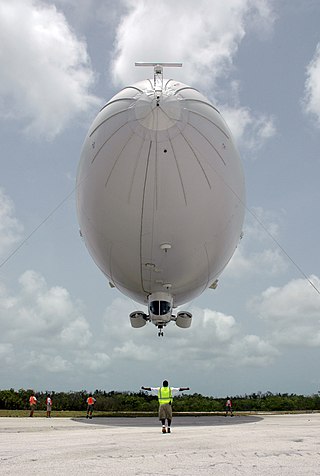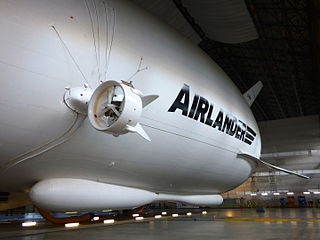
An airship or dirigible balloon is a type of aerostat or lighter-than-air aircraft that can navigate through the air under its own power. Aerostats gain their lift from a lifting gas that is less dense than the surrounding air.

The Lockheed Martin X-33 was a proposed uncrewed, sub-scale technology demonstrator suborbital spaceplane that was developed for a period in the 1990s. The X-33 was a technology demonstrator for the VentureStar orbital spaceplane, which was planned to be a next-generation, commercially operated reusable launch vehicle. The X-33 would flight-test a range of technologies that NASA believed it needed for single-stage-to-orbit reusable launch vehicles, such as metallic thermal protection systems, composite cryogenic fuel tanks for liquid hydrogen, the aerospike engine, autonomous (uncrewed) flight control, rapid flight turn-around times through streamlined operations, and its lifting body aerodynamics.

The Boeing Bird of Prey was a black project aircraft, intended to demonstrate stealth technology. It was developed by McDonnell Douglas and Boeing in the 1990s. The company provided $67 million of funding for the project; it was a low-cost program compared to many other programs of similar scale. It developed technology and materials which would later be used on Boeing's X-45 unmanned combat air vehicle. As an internal project, this aircraft was not given an X-plane designation. There are no public plans to make this a production aircraft. It is characterized as a technology demonstrator.

His Majesty's Airship R100 was a privately designed and built British rigid airship made as part of a two-ship competition to develop a commercial airship service for use on British Empire routes as part of the Imperial Airship Scheme. The other airship, the R101, was built by the British Air Ministry, but both airships were funded by the Government.

Cardington is a village and civil parish in the Borough of Bedford in Bedfordshire, England.

A hybrid airship is a powered aircraft that obtains some of its lift as a lighter-than-air (LTA) airship and some from aerodynamic lift as a heavier-than-air aerodyne.

The Lockheed Martin P-791 is an experimental aerostatic and aerodynamic hybrid airship developed by Lockheed Martin. The first flight of the P-791 took place on 31 January 2006 at the company's flight test facility at United States Air Force Plant 42 in Palmdale, CA.

The Northrop Grumman X-47B is a demonstration unmanned combat aerial vehicle (UCAV) designed for aircraft carrier-based operations. Developed by the American defense technology company Northrop Grumman, the X-47 project began as part of DARPA's J-UCAS program, and subsequently became part of the United States Navy's Unmanned Combat Air System Demonstration (UCAS-D) program. The X-47B is a tailless jet-powered blended-wing-body aircraft capable of semi-autonomous operation and aerial refueling.
SkyCat is a class of proposed heavy-lift hybrid airships which derive more than half of their lift by helium buoyancy and the balance via aerodynamic lift produced by aerodynamic shaping. The SkyCat design incorporates hover cushion technology in place of wheels, allowing craft to take off and land anywhere, including remote regions without need for airports or sophisticated forward based infrastructure.

The aerospace industry of the United Kingdom is the second-largest national aerospace industry in the world and the largest in Europe by turnover, with a global market share of 17% in 2019. In 2020, the industry employed 116,000 people.

Hypersonic flight is flight through the atmosphere below altitudes of about 90 km at speeds greater than Mach 5, a speed where dissociation of air begins to become significant and high heat loads exist. Speeds over Mach 25 have been achieved below the thermosphere as of 2020.
Aeros Corp is an American manufacturer of airships based in Los Angeles, California. It was founded in 1993 by the current CEO and Chief Engineer, Igor Pasternak, who was born in Soviet Kazakhstan, raised in Soviet Ukraine, and moved to the U.S. after the Soviet collapse to build airships there. It currently employs more than 100 workers.

Cardington Airfield, previously RAF Cardington, is a former Royal Air Force station in Bedfordshire, England, with a long and varied history, particularly in relation to airships and balloons.

Airship Industries was a British manufacturers of modern non-rigid airships (blimps) active under that name from 1980 to 1990 and controlled for part of that time by Alan Bond. The first company, Aerospace Developments, was founded in 1970, and a successor, Hybrid Air Vehicles, remains active as of 2022. Airship Industries itself was active between 1980 and 1990.

The Hybrid Air Vehicles Airlander 10 is a hybrid airship designed and built by British manufacturer Hybrid Air Vehicles (HAV). Comprising a helium airship with auxiliary wing and tail surfaces, it flies using both aerostatic and aerodynamic lift and is powered by four diesel engine-driven ducted propellers.
The Blue Devil blimp was a proposed reconnaissance airship that was built for the United States Air Force for use in the War in Afghanistan. It was designed to capture and process data from onboard sensors before delivering it to ground troops.

The RED A03 is a V12 four-stroke aircraft diesel engine designed and built by RED Aircraft GmbH of Adenau, Germany.

A hypersonic weapon is a weapon capable of travelling at hypersonic speed, defined as between 5 and 25 times the speed of sound or about 1 to 5 miles per second.
















